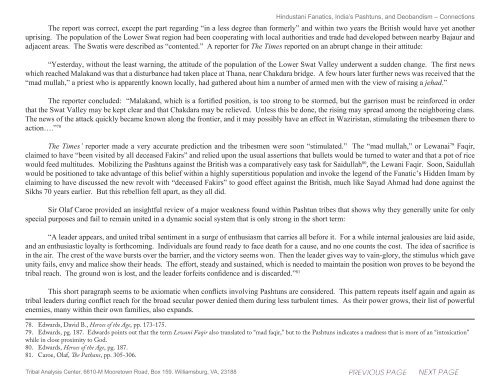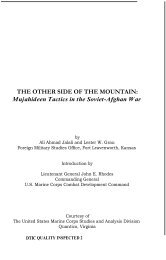Hindustani Fanatics, India’s Pashtuns, <strong>and</strong> Deob<strong>and</strong>ism – Connections“The mystique of Syed Ahmad, both as martyr <strong>and</strong> lost leader in waiting, had grown over the years <strong>and</strong> to many young men of faith he nowcame to be seen as a unique symbol of Islamic resistance <strong>and</strong> resurgence…. Large numbers of mujahedin volunteers responded to the call, amongthem a devout but unusually independent-minded mullah from Hyderabad named Maulvi Zain ul-Abdin, who had been converted to Wahhabism byWilyat Ali during one of his visits to the city. Traveling across India in small parties to escape detection, Zain ul-Abdin <strong>and</strong> almost a thous<strong>and</strong> recruitsfrom the Deccan 75 made their way to Sittana to begin their military training. However, Zain ul-Abdin was determined to meet the Hidden Imam whosecall he <strong>and</strong> his fellow Hyderabadis had answered. He dem<strong>and</strong>ed to see the Amir ul-Momineen <strong>and</strong>, after being repeatedly fobbed off with excuses,was finally led into the mountains above the Hindustani camp to a point where he <strong>and</strong> a number of other curious mujahedin could make out a distantcave, at the entrance of which stood three figures dressed in white robes. These, he was told, were the Amir ul-Momineen <strong>and</strong> the two disciples whoattended to his daily needs. The spectators were then made to promise not to go any closer, because if they or anyone else did so the Hidden Imamwould again disappear, <strong>and</strong> remain hidden from the sight of man for fourteen years.“Thrilled as he <strong>and</strong> the others were by this distant glimpse of their leader, Zain ul-Abdin found himself unable to contain his curiosity. Finally,he <strong>and</strong> a number of comrades bolder than the rest went back up the mountain to take a closer look. They clambered right up to the cave <strong>and</strong> found, totheir horror, that the three figures were nothing more than effigies. As Zain ul-Abdin later reported it, he examined the figure of the supposed imam‘<strong>and</strong> found it was a goatskin stuffed with grass, which with the help of some pieces of wood, hair, etc. was made to resemble a man. The supplicantenquired from Qasin Kazzab [Maulvi Qasim Panipati, the Wahhabi’s caliph at Sittana] about this. He answered that it was true, but that the ImamHumam had performed a miracle, <strong>and</strong> appeared as a stuffed figure.“Thoroughly outraged by this deception, Zain ul-Abdin promptly decamped from Sittana together with most of his thous<strong>and</strong> volunteers fromHyderabad.” 76The followers of Sayed Ahmad Shah were far from being finished with their attacks on the British, however. A British intelligence assessmenton the “Hindustani Fanatics” prepared in 1895 concluded:“…[I]t will be seen that during the past half century the Hindustanis have come into collision with us on no less than six occasions; eachtime they have suffered severely <strong>and</strong> been obliged to shift their residence, but, as was stated at the beginning of the report, they still remain a factorfor mischief, although in a less degree than formerly, in any complication which may arise with the independent tribes on this part of the Punjabfrontier.” 7775. From Wikipedia: The Deccan Plateau, also known as the Peninsular Plateau or the Great Peninsular Plateau, is a large plateau in India, making up the majority of thesouthern part of the country. It is located between three mountain ranges <strong>and</strong> extends over eight Indian states. Its upl<strong>and</strong>s make up a triangle nested within the familiardownward-pointing triangle of the Indian sub-continent’s coastline. It is technically a vast plateau with a wide range of habitats, encompassing most of central <strong>and</strong> southernIndia.76. Allen, pp. 105-106. This story may be apocryphal as there is a similar story about Dost Mohammad’s eunuch wazir investing this cave <strong>and</strong> making the same discovery.There are either two stories or there were two separate visits to the same cave with its effigies.77. Mason, A.H., Report on the Hindustani Fanatics, Simla. 1895, pg. 15.Tribal Analysis Center, 6610-M Mooretown Road, Box 159. Williamsburg, VA, 23188
Hindustani Fanatics, India’s Pashtuns, <strong>and</strong> Deob<strong>and</strong>ism – ConnectionsThe report was correct, except the part regarding “in a less degree than formerly” <strong>and</strong> within two years the British would have yet anotheruprising. The population of the Lower Swat region had been cooperating with local authorities <strong>and</strong> trade had developed between nearby Bajaur <strong>and</strong>adjacent areas. The Swatis were described as “contented.” A reporter for The Times reported on an abrupt change in their attitude:“Yesterday, without the least warning, the attitude of the population of the Lower Swat Valley underwent a sudden change. The first newswhich reached Malak<strong>and</strong> was that a disturbance had taken place at Thana, near Chakdara bridge. A few hours later further news was received that the“mad mullah,” a priest who is apparently known locally, had gathered about him a number of armed men with the view of raising a jehad.”The reporter concluded: “Malak<strong>and</strong>, which is a fortified position, is too strong to be stormed, but the garrison must be reinforced in orderthat the Swat Valley may be kept clear <strong>and</strong> that Chakdara may be relieved. Unless this be done, the rising may spread among the neighboring clans.The news of the attack quickly became known along the frontier, <strong>and</strong> it may possibly have an effect in Waziristan, stimulating the tribesmen there toaction….” 78The Times’ reporter made a very accurate prediction <strong>and</strong> the tribesmen were soon “stimulated.” The “mad mullah,” or Lewanai 79 Faqir,claimed to have “been visited by all deceased Fakirs” <strong>and</strong> relied upon the usual assertions that bullets would be turned to water <strong>and</strong> that a pot of ricewould feed multitudes. Mobilizing the Pashtuns against the British was a comparatively easy task for Saidullah 80 , the Lewani Faqir. Soon, Saidullahwould be positioned to take advantage of this belief within a highly superstitious population <strong>and</strong> invoke the legend of the Fanatic’s Hidden Imam byclaiming to have discussed the new revolt with “deceased Fakirs” to good effect against the British, much like Sayad Ahmad had done against theSikhs 70 years earlier. But this rebellion fell apart, as they all did.Sir Olaf Caroe provided an insightful review of a major weakness found within Pashtun tribes that shows why they generally unite for onlyspecial purposes <strong>and</strong> fail to remain united in a dynamic social system that is only strong in the short term:“A leader appears, <strong>and</strong> united tribal sentiment in a surge of enthusiasm that carries all before it. For a while internal jealousies are laid aside,<strong>and</strong> an enthusiastic loyalty is forthcoming. Individuals are found ready to face death for a cause, <strong>and</strong> no one counts the cost. The idea of sacrifice isin the air. The crest of the wave bursts over the barrier, <strong>and</strong> the victory seems won. Then the leader gives way to vain-glory, the stimulus which gaveunity fails, envy <strong>and</strong> malice show their heads. The effort, steady <strong>and</strong> sustained, which is needed to maintain the position won proves to be beyond thetribal reach. The ground won is lost, <strong>and</strong> the leader forfeits confidence <strong>and</strong> is discarded.” 81This short paragraph seems to be axiomatic when conflicts involving Pashtuns are considered. This pattern repeats itself again <strong>and</strong> again astribal leaders during conflict reach for the broad secular power denied them during less turbulent times. As their power grows, their list of powerfulenemies, many within their own families, also exp<strong>and</strong>s.78. Edwards, David B., Heroes of the Age, pp. 173-175.79. Edwards, pg. 187. Edwards points out that the term Lewani Faqir also translated to “mad faqir,” but to the Pashtuns indicates a madness that is more of an “intoxication”while in close proximity to God.80. Edwards, Heroes of the Age, pg. 187.81. Caroe, Olaf, The Pathans, pp. 305-306.Tribal Analysis Center, 6610-M Mooretown Road, Box 159. Williamsburg, VA, 23188
- Page 7 and 8: Hindustani Fanatics, India’s Pash
- Page 9 and 10: Hindustani Fanatics, India’s Pash
- Page 11 and 12: Hindustani Fanatics, India’s Pash
- Page 13 and 14: Hindustani Fanatics, India’s Pash
- Page 15 and 16: And Charles Allen described the sce
- Page 17 and 18: Hindustani Fanatics, India’s Pash
- Page 19 and 20: Charles Allen provided additional d
- Page 21: Hindustani Fanatics, India’s Pash
- Page 25 and 26: Hindustani Fanatics, India’s Pash
- Page 27 and 28: Hindustani Fanatics, India’s Pash
- Page 29 and 30: that Shah Waliullah’s ancestors w
- Page 32: Hindustani Fanatics, India’s Pash
- Page 35 and 36: Hindustani Fanatics, India’s Pash
- Page 37 and 38: Hindustani Fanatics, India’s Pash
- Page 39: Hindustani Fanatics, India’s Pash
- Page 42 and 43: Hindustani Fanatics, India’s Pash
- Page 44 and 45: Hindustani Fanatics, India’s Pash
- Page 46 and 47: Hindustani Fanatics, India’s Pash
- Page 48 and 49: Hindustani Fanatics, India’s Pash
- Page 50 and 51: Hindustani Fanatics, India’s Pash
- Page 52 and 53: Hindustani Fanatics, India’s Pash
- Page 54 and 55: Hindustani Fanatics, India’s Pash
















